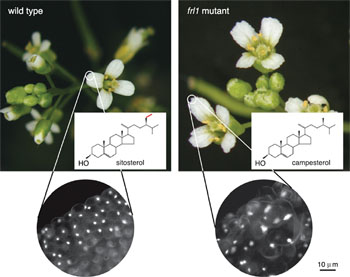6-2 | Sterol Composition Determines Petal Shape |
 This picture.(52KB) |
||
|
|
Sterols are membrane components which play an important role in regulating membrane fluidity and permeability. Whereas mammalian cells mainly contain one major sterol, cholesterol, plant cells characteristically have a mixture of sterols in which sitosterol is generally predominant. The Arabidopsis frl1 mutant that has serrated petals was isolated using a carbon-ion beam as a mutagen. We have succeeded in identifying the causal gene of the frl1 mutant. The FRL1 gene encodes the SMT2 (STEROL METHYLTRANFERASE 2) protein that is effective in sterol biosynthesis. The frl1 mutant has a single-base deletion in this gene. The SMT2 is involved in the methyl-addition step at carbon 28, which is necessary for synthesis of sitosterol. Sitosterol makes up 65% of sterols in wild-type Arabidopsis. In the frl1 mutant, the amount of sitosterol has been greatly reduced, whereas the amount of campesterol, which is not methylated at carbon 28, has become predominant (Fig. 6-3). SMT2 is thought to be conserved in most plant species. This study raises the possibility of changing petal shapes by changing the level of SMT2 activity. |
|
Reference
Y. Hase et al., Ectopic Endoreduplication Caused by Sterol Alteration Results in Serrated Petals in Arabidopsis, J. Exp. Bot., 56(414), 1263 (2005). |
| Select a topic in left column |
|
|
Persistent Quest Research Activities 2005
Copyright (C) Japan Atomic Energy Research Institute |